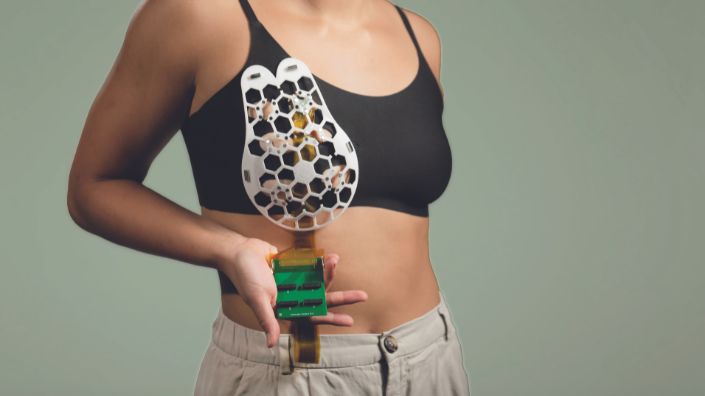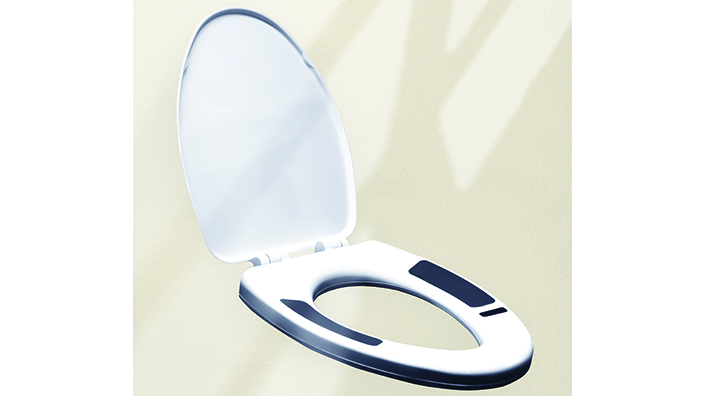These technologies, whether recently launched or still in development, aim to improve patient outcomes and relieve the burden on healthcare professionals and providers.
From minimally invasive treatments for cancer to toilet seats that measure vital signs, and bras that detect breast cancer to implantable soft robotics that deliver tailored drugs, these innovations have the potential to revolutionise healthcare of the future.
We put the spotlight on 10 engineering innovations designed to improve healthcare experiences for patients and doctors. Here are the first three – make sure to check the Professional Engineering homepage throughout the week for the rest.
1: Soft robotics in bowel cancer surgery

Bowel cancer, also known as colorectal cancer, is treated using a combination of different treatments, with surgery being the main and most effective.
“There is a trend towards treatments using minimally invasive approaches, since these reduce risk for the patient and cost. However, the existing tools for procedures to cut and remove tumours are limited to manual endoscopes, which suffer from limited dexterity,” says Ferdinando Rodriguez y Baena, professor of medical robotics in the Department of Mechanical Engineering at Imperial College London.
Having conducted research into soft robots for minimally-invasive surgery for a number of years, the Imperial team has developed a soft robotic manipulator intended for use in colorectal surgery.
Baena says: “By offering the option of performing surgery endoluminally with dexterity and precision that would rival open surgeries, the system we are proposing has the potential to improve care and reduce risks.
“The robot is unique since it uses pressure for actuation and has a morphing design, where its silicone structure deforms internally to maximise force when pressurised. We believe that the use of pressure for actuation, rather than the more traditional tendons, can enable surgeries deep in the colon, without being affected by bends in the transmission lines.”
Having produced one robot arm to demonstrate the effectiveness of the actuation concept, a bi-manual version is now under way where one arm can carry a surgical scalpel and the other a gripper.
2: Wearable breast cancer monitor

Breast cancer patients have an almost 100% survival rate if the disease is detected early. However, if it goes unnoticed until the later stages, the survival rate drops to around 25%.
Massachusetts Institute of Technology researchers have created a wearable ultrasound device that can detect breast cancer early by taking regular images of the breast tissue.
With the use of a piezoelectric material, the research team was able to miniaturise the ultrasound scanner. The scanner is then housed in a flexible, 3D-printed patch that features honeycomb-like openings to ensure contact with the skin. The miniature scanner can be moved to six positions and can also rotate to ensure that the entire breast is scanned.
Attached to a bra using magnets, the patch can be used over and over again by those who are at high risk of breast cancer and by those who don’t have regular access to screening.
“This work will significantly advance ultrasound research and medical device designs, leveraging advances in materials, low-power circuits, AI algorithms and biomedical systems,” says Professor Anantha Chandrakasan, dean of MIT’s School of Engineering.
3: Smart toilet seat monitors vital signs

Patients suffering with chronic conditions often require regular monitoring by healthcare professionals. However, outside a healthcare setting this becomes challenging.
US-based Casana has developed a product that enables consistent and accurate at-home health monitoring throughout the day. Known as the Heart Seat, this smart toilet seat is embedded with sensors to measure a patient’s vital signs.
Austin McChord, CEO of Casana, says: “The key component of this technology is that it’s truly effortless – it doesn’t take any additional time out of your day.”
With the Heart Seat having been cleared by the US Food and Drug Administration for measuring heart rate and oxygen saturation, Casana is now working with researchers to also integrate blood pressure measurements into the seat.
Data from the battery-powered seat is transmitted via wi-fi to the Casana Cloud. This data and resulting insights can easily be viewed through a clinician interface.
“The seat could save valuable time for both providers and patients, potentially replacing doctors’ visits and hopefully some day hospital readmissions. By unobtrusively collecting key vital signs, you might even forget it’s there. It’s technology like this that truly makes our lives better,” says McChord.
Want the best engineering stories delivered straight to your inbox? The Professional Engineering newsletter gives you vital updates on the most cutting-edge engineering and exciting new job opportunities. To sign up, click here.
Content published by Professional Engineering does not necessarily represent the views of the Institution of Mechanical Engineers.